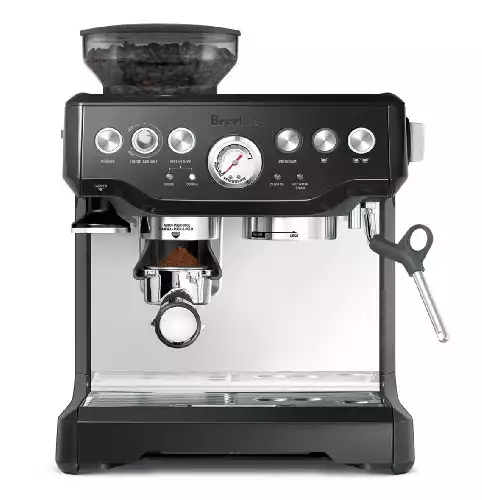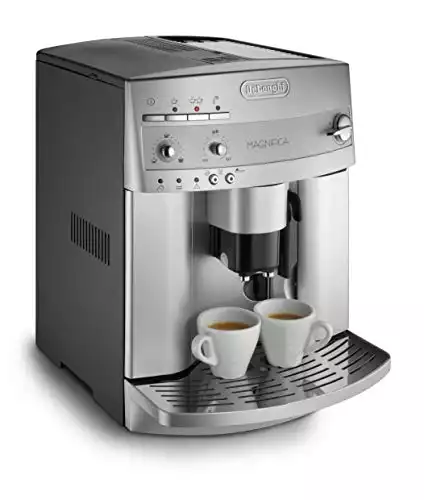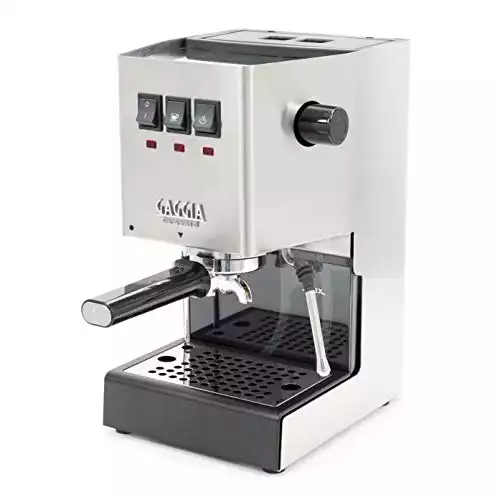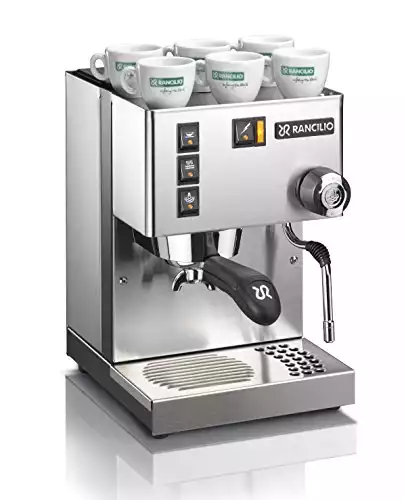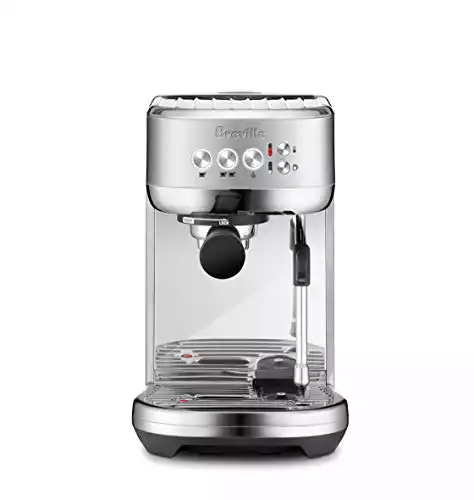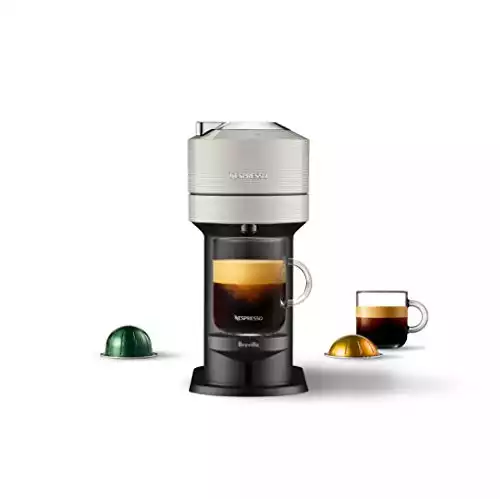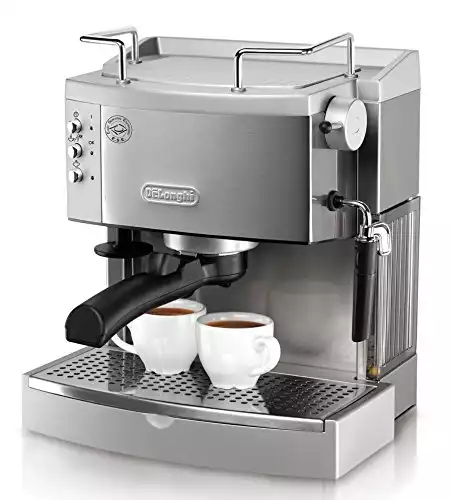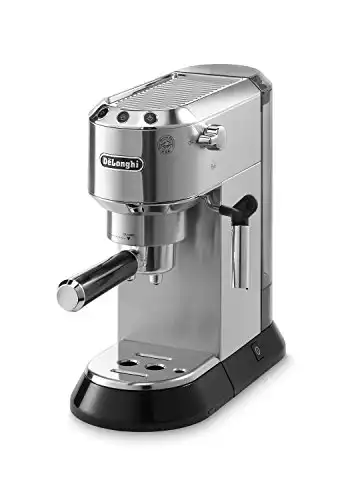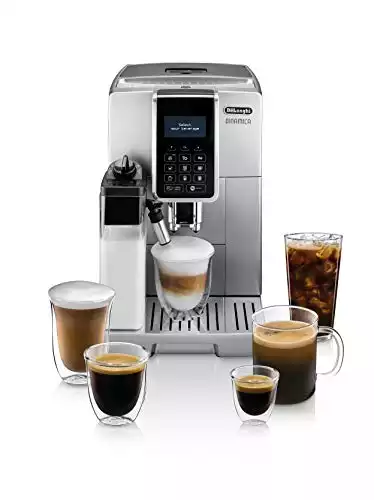The Best Espresso Machine 2024 Ultimate Guide
Once you start to appreciate coffee in espresso form, it gets even more addictive. It’s a natural progression to want to make it yourself right at home.
Below, we’ve put together 9 of the best home espresso machines you can consider for your home brewing pleasure.
Check them out to see what best fits your requirements so that you can enjoy quality coffee at home. But, if you’re in a rush, here’s our top pick of the bunch:
Alternative Espresso Machines At A Glance
The 9 Best Espresso Machines 2024
Let’s get right to it! Below are 8 espresso machine options. We’ve put together a mix of automatic and semi automatic options to satisfy a wide range of espresso preferences.
See which coffee maker aligns with your preferences best, based on the pros and cons outlined below.
1. Breville BES870BSXL Barista Express Espresso Machine
I’ve had quite a bit of facetime with this Breville Barista Express machine, from so many personal home-brewing training sessions to small cafes. It packs a punch for its size and price.
While it’s a super slick home brewer, Its most amazing feat is powering a little cafe I consulted for a few years ago.
PROS (+)
- Has a built in burr grinder
- Decent steam wand for its size and price
- Can cater to the demands of a large household
CONS (-)
- Grinder has a hard time with lightly roasted beans
- Can be sensitive to overheating when the water reservoir empties while brewing
It feels like Breville really took the time to get to know home brewer habits, and the Breville Barista Express hits the spot regardless of if you enjoy a latte, macchiato, or a shot of espresso.
The brew temperature is programmable, and it comes with filter baskets optimized for single or double shots. Aside from that, it has unique filter baskets to help you maximize the crema from your favorite ground coffee beans!
I’ve been recommending this Breville machine for years, and I will continue to do so for aspiring home baristas. It’s as close as you can get to a commercial espresso machine, but you pay about a third of the price. I believe that Breville has positioned itself as a premium brand among home brewers and right at the beginning of workable commercial machines.
If you find this to be a suitable pick for you and have some space in your budget, I would consider an upgraded grinder – although it’s not essential. Aside from that, everything that this machine does is up to standard for home brewing in my book!
2. De’ Longhi ESAM3300 Magnifica Super Automatic Espresso & Coffee Machine
This is the best automatic machine, in my opinion. It has a simple interface that’s easy to understand. From this, you can choose to have the machine make 5 classic espresso recipes with the push of a button!
PROS (+)
- Powerful machine that stays primed to brew for as long as the water tank is filled
- Adjustable group head height that can accommodate many different cup sizes
- Simple to clean design
CONS (-)
- Built in grinder struggles with dense or oily beans
- Some concerns about warranty claims
If you’re in the market for a super automatic espresso machine, this could be a good pick for you. De’ Longhi is a known brand for quality when it comes to coffee.
The main strength of automatic espresso makers is that they’re simple to use, fast, and consistent. When it comes to the Magnifica, that’s certainly true.
It also helps that it shouldn’t be a problem with the global reach of De Longhi to get your machine serviced if the need arises!
If you need more info about automatic machines, we discuss the main differences between automatic and semi automatic espresso makers in our buying guide at the end.
Check out our full ESAM3300 review of this Delonghi brewer for more details.
3. Gaggia RI9380/46 Classic Pro Espresso Machine
If I were currently in the market for a semi automatic espresso machine without a built-in grinder, the Gaggia Classic Pro would be my pick.
PROS (+)
- Great espresso
- The perfect manual steam wand
- Built with reduced noise during extraction without affecting quality
CONS (-)
- You will need to buy a separate burr grinder
Its solenoid valve is the superpower of this brewer, and the steaming power literally blows you away! It sets you up to steam coffee shop quality milk in your kitchen. No other semi automatic compares at this price point, so if you’re a fan of lattes, check this out.
Aside from the group head and boiler makeup, I also love how the design would work well with almost any space.
If you read customer reviews as much as I do, there are almost no complaints about the quality of espresso that this machine makes. While its brushed stainless steel exterior is simple, much of this brewers’ worth is masked internally.
I would recommend the Gaggia Classic Pro for those who also have a budget for a good grinder. Especially for those of you who want to explore the finer flavors of drinking barista-style espresso-based coffee beverages.
4. Rancilio Silvia Espresso Machine
If you only compare the externals, the Silvia won’t stand out. I noticed this machine on an espresso bar in a sizable restaurant where I was hired to consult. They didn’t specialize in coffee, so I didn’t expect much when I ordered an espresso. After my first sip, I was pleasantly surprised with the quality!
That’s when I had a chat with the barista, and eventually, the owner I got up close with the Silvia. As I trained their staff on crafting espresso with it, I realized that the minimalist exteriors distracted you from how well-built this machine is from the inside!
PROS (+)
- Heavy duty group head for brewing consistency
- High brew control
- Good after-sales service
CONS (-)
- Not great for beginners
- No pressure gauge display
If you want your espresso good, consistent, and with high control, the Silvia could be an easy pick. This coffee machine is for you if you identify with quality over aesthetics.
However, this brewer isn’t suited to beginners as the controls as in symbols, and there’s no pressure gauge.
Nonetheless, brands like Breville and Rancilio, especially the Barista Express, and the Silvia coffee makers are my favorites for home espresso making.
Related reads: Rancilio Silvia 2024 review, Prosumer Espresso Makers
5. Breville BES500BSS Bambino Plus Espresso Machine
What’s amazing about this Breville Bambino Plus espresso maker is what it does for its size. It’s almost just as big as an electric home grinder!
While this Breville brewer doesn’t have a built-in grinder like the Barista Express, you certainly will still have enough room to pair it with most options. With the signature modern stainless steel design that most Breville machines come with, it should be a fun addition to most spaces.
PROS (+)
- Built-in pre-infusion for a deeper extraction
- Automatic, programmable milk frothing for consistency
- Fast warm up time so can enjoy your espresso without waiting
CONS (-)
- Water tank design could be better
- Brew pressure can be inconsistent
Breville is a well-known brand in the coffee and espresso realm. Their machines are innovative, and each seems to be designed to satisfy a specific type of coffee drinker.
This particular Breville espresso machine was made for home drinkers who can’t live without 1 or 2 cup servings a day.
If you find yourself in the double-digit range of espresso drinks per day, one thing you might find about this machine is that the drip tray is small.
Otherwise, this could be a perfectly healthy pick for those espresso and cappuccino drinkers who want to make their drinks themselves.
Related Read: Breville Bambino Plus Review
6. Nespresso Vertuo Next Coffee & Espresso Machine
Alright, the Nespresso might not be your traditional espresso maker, but if you value convenience and ease, it’s top of the pile.
PROS (+)
- Barcode reader delivers a consistent brew
- More than half of your machine is made from recycled materials
- Can brew with 6 different cup sizes
CONS (-)
- Subject to water leaks during and after brewing
The space-and-environment-saving aspects of this home espresso machine make it one of my favorite capsule machines overall. 54% of each Vertuo Next machine is made from recycled material, and it has an auto-shutoff feature to help you reduce energy consumption.
If you think automatic machines brew coffee the same way each time, this particular one has a system where it brews according to set parameters set per capsule. Depending on which capsule you place into the brewer, it’ll adjust automatically.
If making your own cup of coffee isn’t your thing, but you still want variety, this could be the best pick for you on this list. It’s an environmentally sound espresso and cappuccino maker that is one of the more modern machines on this list.
I would classify this as one of the best espresso machines when it comes to single serve brewing. Especially since it can brew something akin to espresso. A gift to coffee lovers who primarily enjoy drinking single serve coffee!
Related read: Nespresso Brewers 2024
7. De’ Longhi EC702 Espresso Maker
If you’re on a budget but are in the market for a semi automatic espresso machine, this entry from De’ Longhi could be for you! It covers all the basics you need to create the best espresso you can at home, wrapped in a stainless steel body.
When it comes to coffee, building up knowledge of each brewing process will take you far enough. Machines will only serve as extensions of how you want to brew.
PROS (+)
- Super budget friendly
- Compatible with E.S.E. (Easy Serving Espresso) pods or ground coffee
CONS (-)
- Heat and steam sealers aren’t the most robust
If you’re the type who wants to learn the basics before slowly upgrading equipment, this is the best espresso machine to start off with.
Espresso machines have a break-in period. The best ones, I believe, are the easiest to use. This only means that if you can master steaming and making good double shot espressos on budget machines, you’ll be primed to use an upgraded machine later on!
Read our full EC702 review here.
8. De’ Longhi EC680M Dedica Espresso Machine
Of all the espresso machines on this list, this one takes up the least space! It’s exactly the type of machine you purchase if you have room for a small espresso set up at home!
You can do everything that larger machines can, but with very little space. With enough pulls, you can make up for the proportional size-to-power ratio with better technique.
PROS (+)
- Takes up only a foot of space on your kitchen counter
- Primes itself to pull espresso in less than 1 minute
- Adjustable drip tray to accommodate tall cups
CONS (-)
- Not the best steaming power
What I absolutely love about tiny espresso machines is how you can craft your favorite drinks without the bulk of huge shop machines.
It’s an absolute nightmare when a machine is too big for an allotted space. Your workflow gets affected, especially if you’re the type who likes a comfortable space to work.
In a home setting, managing space is even more crucial since there’s more going on in each area of your home. Learning to master these machines will prove that you some compromise, even with the best espresso machines is possible, while still allowing you to have that barista touch!
Read our full Dedica review to learn more about this pick.
9. De’ Longhi ECAM35075SI Dinamica Fully Automatic Espresso Machine
The knock-on most automatic espresso machines is that your options are limited. That was before De’ Longhi went ahead and invented an espresso machine with 18 built-in recipes.
This is the solution for coffee drinkers who love different coffees but don’t love making them. With 18 drinks at your disposal with the push of a button, it’s almost like you have your own personal barista at home.
PROS (+)
- Milk frother works well even with alternative milks
- 18 built-in espresso-based recipes
- Easy-clean, dishwasher compatible parts
CONS (-)
- Water reservoir is hard to reach
- Milk components need extra cleaning and maintenance
If you’re the type of person that enjoys milky espresso-based drinks, then this could be the best pick for you on this list. It’s the best espresso machine for milk drinks!
Espresso Machine 2024 Buyers Guide
Now that you’ve had a look at 9 of the best espresso machines of 2020, here’s a quick buyer’s guide to help the home barista in you pick a suitable machine.
Remember to get something that will be fun and easy to use for you. Get to know if you enjoy drinking espresso or even the overall brewing process itself. This, among a few other considerations, will help your next coffee investment be very satisfying.
The best espresso machines would be of little value if you underutilized them. On the other hand, the most basic coffee machine can also turn you off and make you brew espresso less. This is why it’s important to know what you want and how you want it.
Size Matters
It’s something we’re in denial about sometimes, but almost always true.
Given the price points of espresso machines (yes, even home espresso machines), it’s an investment that requires thought. The right machine can add so much value, and the wrong one can really hurt your wallet!
For example, why go for a 2-group espresso machine if you’re just brewing for yourself? In fact, why force a dual boiler system if you only make 2-4 cups of coffee a day?
Once you know the amount of espresso you drink regularly, choose a quality machine that can fulfill your personal demand. Remember that once you get past your honeymoon phase with making espresso yourself, your demand will shrink back from its mini peak.
On the flip side, if you’re a big family, or if you have friends over a lot and you’ll be slinging 8-10 espresso-based drinks at a time, then a dual boiler machine makes sense. See what fits your coffee needs and decide based on that.
What do you drink?
Being aware of these preferences will spell all the difference between needing (or wanting) an automatic espresso machine, or a semi automatic espresso maker. The question is:
Are you a black coffee drinker?
Do you like milk drinks?
Do you like creating recipes?
If you just want your coffee with a push of a button, there’s a super automatic espresso and cappuccino maker in the market right now. Whereas If you don’t stray too far away from classic espresso-based options, again, that automatic machine with a built in grinder might suffice for your needs. Sometimes home brewers just want to drink coffee.
However, if you were a barista in your past life and thoroughly enjoy it every time you make espresso, I would strongly suggest a semi automatic machine. It’s every home barista’s dream come true to craft coffees in the comfort of their own kitchen.
If you have a need for multiple black coffees in one go, within a short amount of time, I also suggest getting an espresso maker with a big water tank.
Long blacks (or Americano’s to some) use a lot of water from the boiler. So if you need them in fast spurts, a large water tank and boiler size will help speed things up.
It’s also important to note that an overworked machine is hard to maintain. It will last considerably less than advertised if it’s worked harder than it was intended to be. The only machine I’ve seen exceed expectations at home is the Breville Barista Express in my coffee career.
Everyone needs space
This is an area (pun intended) that is often overlooked. Sometimes we become so focused on selecting the best espresso machine that we forget about compatibility.
Do I have enough space on what’s left of my kitchen counter? Are my outlets compatible with it? Do I have enough energy allotment to operate the machine and the grinder?
Espresso machines are heavy-duty, but most of them aren’t built to be moved around a lot. Planning this far, even before buying, can spell all the difference in maximizing your coffee investment.
If you put your machine in a bad spot, that opens you up to more accidents in the kitchen when you make espresso. This coffee maker usually takes up more space than your old Mr. Coffee drip machine so you need to prepare accordingly.
Ball on a budget
Once you’re in the market, you will quickly realize that there will be so many espresso machine options right now. Remember to focus on quality, but also look for options within your budget range.
Learn to prioritize certain features according to what’s important to you. Regardless if that’s pulling shots or steaming milk. Remember, brewers which make black coffee are often less feature rich than those which focus on milk drinks. Consider the speed of the espresso machine if you’re going to be brewing a lot and often.
Read customer reviews. Just remember, the best coffee machine is a highly opinionated topic. Narrow down on your priorities and blank out everything else!
Lastly, If you’re getting a semi automatic espresso machine, remember that it’s equally important to get a good burr grinder as well! So leave space in your budget for that.
Related Read: Budget Espresso Makers
Know your purpose
As crazy as it sounds, I’ve encountered a lot of people who buy with the next step in mind. This comes in the form of getting an expensive machine with the intention of eventually opening up a cafe. Sometimes, they get really cheap options and end up not enjoying the best espresso at home too.
If you do your homework, know your espresso preferences, and do your thing, you’ll end up having this brew method at home for sure. It’s the base of so many good new and classic recipes!
A good brand to start with for me is Breville, since as I mentioned above, it feels like a premium home brewing brand, and an entry-level commercial brand. Rancilio, the brand behind the Silvia on the list above, could also be a close second for me.
This is why it’s essential to choose the proper machine for you. Align it with how deep you want to go into brewing espresso, and decide accordingly. If you just like drinking it, get an automatic machine. If you like making it, get a basic semi automatic machine. Whereas If you wanna get better and better in the art of pulling espresso shots, get a dual boiler, single group machine.
Looks Matter
Lastly, if you’re going to go out and buy a huge coffee investment, one last thing to consider is how much you like the aesthetics.
Remember that you come face-to-face with your machine before you’ve had your morning cup. It helps to have an espresso station that you love being in as well! I am particularly fond of how coffee equipment from Breville all look similar and neutral, making it easy to arrange them on almost any bar.
Espresso Jargon
Here’s a quick guide on some terms that you will eventually come across when you start brewing with your espresso machine. It would be good even for the home barista to get familiar with these, to understand and maximize your espresso maker at home.
Portafilter – this is what holds your filter basket, what you lock into the group head of your espresso machine. It’s a heavy-duty piece of equipment because it has to withstand 9-15 bars of pressure per shot of espresso you make.
Filter Basket – this is where you place your finely ground coffee. Depending on your preference, espresso machines usually come with single or double shot options.
PSI – means “Pounds per square inch.” It is the unit of measurement used to gauge the bars of pressure inside your dual or single-boiler espresso machine. Check the manual of your espresso maker to see which parameters are ideal for your boiler pressure. Espresso machines can be sensitive to power fluctuations, so they’re best used with automatic voltage regulators.
Steam Wand – this is what incorporates hot steam into your milk to create the best creamy milky espresso drinks. It’s easy to use, but very important to maintain properly. Clean this part of your espresso maker before and right after you use it. The longer you wait, the harder it gets to clean. Poorly maintained steam wands can really mess up your machine or lead to a poor foamy brew in your cup
Single/Dual Boiler – a boiler is a pressurized chamber in espresso machines that heat water to a specific temperature before it’s used for making espresso. A single boiler beans for brewing coffee and steaming milk uses water from the same boiler. Therefore, a dual boiler machine means that espresso and milk each have dedicated boilers for each function. Because of this, dual boiler systems generally perform faster than single boiler systems.
Burr Grinder – designed initially as a spice grinder, grinds more evenly by design than blade grinders. It is made up of 2 steel or ceramic burrs that allow coffee (or dry spices) to pass through them according to your size settings. This is the key to making quality espresso (and food). Remember a built in burr grinder will be for grind sizes associated with that that specific brewer.
Semi Automatic Espresso – these are usually the espresso machines in commercial settings described as “traditional” or “manual”. They have a boiler, a portafilter, a steam wand, and a brew switch (or lever). This is the ideal espresso maker for those of us who enjoy being in control of many specific aspects of making espresso.
Super Automatic Espresso – these are espresso makers that do everything for you! Some can grind, brew, and froth with the push of a button. They usually come with pre-set espresso options or a limited set of parameters that you can mix and match for your cup. Pod machines fall under this category as well, with pods counting as pre-ground coffee.
How to Make Espresso
Part of the beauty of making your own espresso at home is eventually developing your own style and workflow. A deeper understanding of how each step in your process affects taste will give you that barista touch.
The first step in getting there is knowing what flavor profile you want to get out of your espresso. After that, it will be figuring out how to use your espresso machine to get there. Remember that if you maximize espresso machines, you need to have a look at the best burr grinders available at your budget.
Below is a sample workflow that I use as a professional barista. This is a general method of how I pull espresso shots in different coffee shops. Layouts can change, but your pillars for making the best espresso should remain.
Keep in mind that I prioritize precision, efficiency, and consistency. I will state each step and outline why it’s crucial to be performed within specific parameters.
Basic Barista Espresso Routine
PHASE I: PREPARATION
The best espresso routines start with understanding.
Know the ideal brew temperature (hot water) of your coffee beans (based on roast profile) and if they work best black (espresso, long black) or with milk (flat white, cappuccino, latte).
Be aware of how long your espresso machine needs to warm up. Does your espresso maker have a digital brew temperature display? Does the display show the hot water’s exact temperature when it comes from the water tank, through the boiler, and out of the group head? How many bars of pressure does your machine brew with?
Lastly, how fast does your steam wand froth? Which angle do you need to aim for to get that coveted vortex? Coffee makers are all different. To know these small details about your equipment could bring you a couple of steps closer to crafting good espresso at home.
Quick Notes:
- I prepare all ingredients and equipment before starting to maximize efficiency.
- Coffee beans, once ground, will lose flavor exponentially. At the 1 minute and 30-second mark, it will lost much of its good flavors. Prep well, and move fast, but calmly.
- For semi automatic machines, extraction starts when your espresso grounds come into contact with heat. With or without water. Make sure that when you lock your portafilter in place, you immediately pull your shot of espresso. Most baristas make the mistake of locking it in place too early, thus heating the beans and priming them for over-extraction.
PHASE II: EXECUTION
When it comes to espresso, remember that “slow is smooth, and smooth is fast”.
You should never hurry, because you’re working with a lot of heat and pressure from espresso machines. At the same time, keep in mind that even without rushing, you will seem fast with familiarity and direction. That is why smooth is a particular type of fast behind the espresso bar.
Dosing
Know the capacity of your filter basket. Measure and dose accordingly. Remember that this is the building block of all your espresso-based recipes and that consistency is achieved by ratios relative to your espresso shot and not set measurements.
Levelling
When the ground coffee is in the filter basket, you need to compress it to add some resistance for when the hot water hits it. This aids with extraction.
Before you tamp, you level. Keep in mind that coffee grounds should be even at the bottom of your filter baskets, so a few good taps or shakes should force your espresso mound to pack the bottom. Evenly filling out the bottom of the baskets instead of leveling just the top helps a lot with consistent, even extractions.
Tamping
The last step before you pull your espresso shot is tamping. It has a straightforward rule that is also applicable to dating: “if you can’t do something the same way from start to finish, don’t do it”.
What does this mean?
Form is very important. It takes some effort to compress coffee grounds into filter baskets.
What works best for me is forming a 90-degree angle with my tamping arm at the elbow while my off arm holds the portafilter steady. From this position, I push down with my sides, not my arm.
Pushing down with an angle different from 90 degrees puts extra strain on your elbows and/or your wrists. While you don’t feel this right away, it slowly builds up over time. Especially if your brew espresso coffee daily.
Even home espresso makers develop wrist and elbow injuries from tamping a few times daily if the form is off.
Once you line your form up nicely, push down with the force needed to achieve the day’s espresso calibration. Find a comfortable position with your shoulders, arms, and hips.
On some days, you’ll need to tamp hard. Other days you can be soft. It all depends on the coffee beans’ freshness, the espresso grinder, and grind settings.
An industry standard when it comes to tamping is around 20 pounds of force. Any harder, and it’s unsustainable.
Pulling The Espresso Shot
As mentioned above, after tamping, all that’s left is to lock the portafilter into the group head. Remember to prepare your cup to catch the espresso so you can hit brew as soon as you lock in. But before doing so, make it a point to clear the rims from coffee grounds.
Besides having more to clean up, leaving them in the group head can add bitterness to your next espresso pull.
When you lock a portafilter into place, remember to keep it at a 6 o’clock angle. At most 7. If you lock it in too tightly, you wear out your rubber gaskets a lot quicker. For semi automatic espresso makers, no matter how good your machine is, it gets worn down by over-tightening.
Remember to place your cup below!
Using Your Milk Frother
Have you noticed how some baristas steam milk during the espresso extraction? Other times, they do it after.
What I’ve found to be uncommon knowledge is that it’s best steam milk before your espresso shot. Why?
If you leave your espresso sitting for too long when you make a milk drink, the crema tends to evaporate. Milk, on the other hand, when steamed well, lasts a long longer.
Get to know the milk frother of your espresso machine. The number of small holes at the bottom will determine how fast it can steam your milk for you.
If the hole of your home espresso maker is wide, it’s probably an extension for cappuccinos. See if it can be unattached for finer milk frothing. Less froth is needed in Lattes and Flat Whites.
Espresso Troubleshooting
ESPRESSO SHOT IS TOO FAST/WATERY/SOUR: Try a combination of grinding finer while maintaining the same weight of coffee grounds in the basket. If the flow is adequate, but the taste is sour, perhaps just brewing a bit longer is your solution. If you still find the espresso sour, double-check the label of your beans. It might be one of the flavor notes of your coffee, after all!
ESPRESSO SHOT IS TOO SLOW/PUNCHY/BITTER: Try a coarser grind size while maintaining the same weight of ground coffee in the portafilter. If the flow is fine and the taste is still bitter, simply reducing the amount of your extraction (or brew time) could be the answer. Bitter coffee is usually a result of over-extraction. See where adjustments can be made, and chase that quality that you’d be happy with.
MILK IS TOO BUBBLY: Find the best angle for your milk frother. A good angle makes a hissing sound. Once you hit this sound, keep your hand steady. Eye-test for the foaminess you’ll need for the type of milky espresso-based drink you’re brewing. Any other oppressive sound while steaming hints at a wrong angle. Good quality milk is creamy and smooth.
MILK IS TOO NOT FOAMY AT ALL: The best type of milk is creamy and silky. If your milk lacks this texture, you probably didn’t aerate it enough. That means your steam wand was too deep into the milk pitcher from the start. Find the appropriate depth to start with that will get you that hissing sound. From there, only make small movements to adjust the level of froth you want in your coffee.
MILK TEMPERATURE: One of the most significant differences between home espresso coffees and coffee shop espresso coffees is usually milk temperature. In cafes, we don’t heat the milk past 65 degrees celsius. This brings out the natural sweetness of the milk. It’s the best way to take milk with espresso because you also end up using less sugar!
If all this detail on making espresso excites you, then a semi automatic machine would be great for your coffee needs. While they could seem daunting for beginner-home-coffee-makers, take it all one phase at a time. It’s all worth it for maximizing the quality of your espresso coffee.
You could also get a fully auto espresso machine. It would take your mind off of a lot of the brewing aspects mentioned above and allow you to experiment mostly with beans and recipes.
The Final Verdict
In summary, the Breville Barista Express is my top pick because I’ve only had good personal experiences with it.
What I give most importance to in espresso makers are consistent brewing temperature, even extractions, and good milk frothing–all of which this Breville machine does well enough for my standards.
See if this works for your coffee needs as well. If not, take enough time and read enough reviews until you come across a machine that addresses your espresso needs.
Enjoy the process, and just keep brewing!

